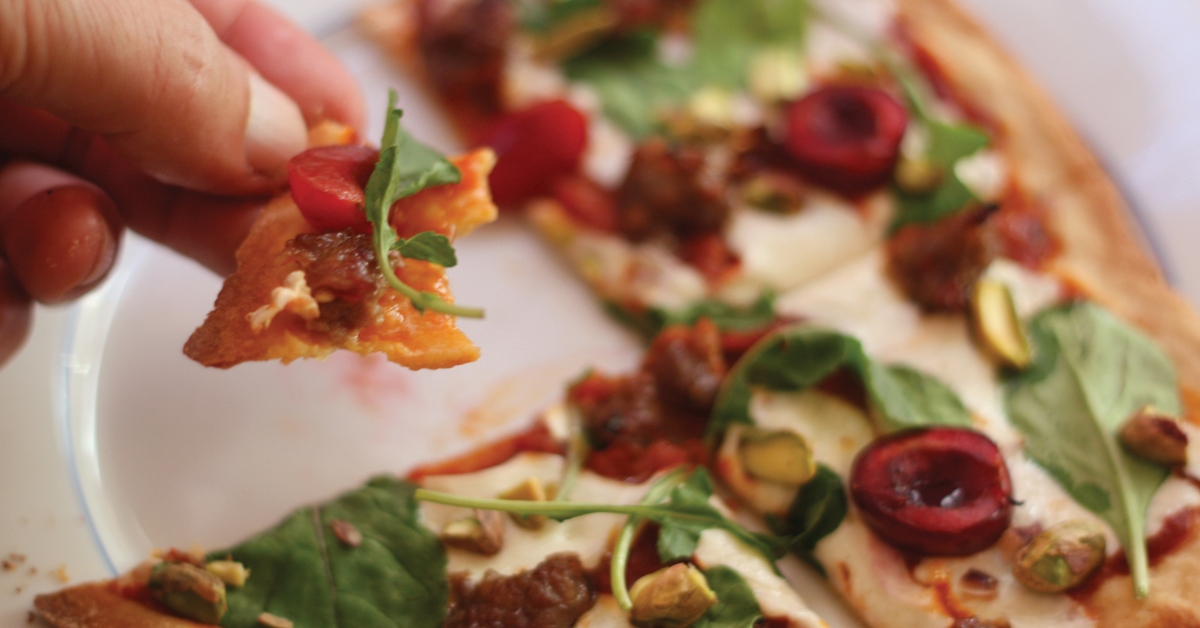By STEVE HEIKKILA
Pizza is often a disappointedly bready affair where the delicious promise of sauce and toppings gets drowned in a doughy sea of blandness. But have you ever had a thin, crispy, cracker crust pizza before? Now that’s a thing of beauty.
I’m talking about crust so thin that it’s hardly noticeable apart from the welcomed bit of crunchy texture it provides. The zesty sauce, cheese, and toppings are the star of the show. It’s also got the added virtue of not being such a carbohydrate bomb, which I also appreciate.
The rub with home-baked cracker crust pizza is that you need an absurdly hot oven to get that crust crispy. This is the basic shortcoming of making any pizza at home, but especially a cracker crust pizza. Pizza ovens run absurdly hot, as in 700° F or higher. Most home ovens only go to 450°.
Or so I thought. I discovered my own home oven—which is by no means a professional kitchen oven but basic Kenmore home oven—goes to 550°. After a good bit of experimentation, I’ve figured out how to make incredibly good cracker crust pizza at home. It’s simple really. You just need to keep a few things in mind.
To ensure the center cooks before the edges burn, make individual-sized pizzas (about 9 inches in diameter) rather than one the size of a manhole cover.
Because you want to roll your cracker crust out to be ultra thin, it helps to use whole wheat flour because it has less springy gluten in it than refined flours. Providing some fiber makes it healthier for you as well.
A pizza stone is essential—it’s cheap and easy to find. You want to put the stone onto the center rack of a cold oven and then heat it to an incendiary 550°F.
Let the oven sit at temperature for a full 30 minutes before you cook your pizzas, to make sure the stone is completely heated through.
The melting point of most silpats is actually lower than 550°F, so don’t cook your pizza on a silpat. Instead, use plain parchment paper.
Go sparingly on the sauce, cheese, and other toppings. Thick application makes the pizza too thick, and the crust won’t crisp up. That means barely a tablespoon of sauce for a 9-inch pizza, a sparse sprinkling of grated cheese that doesn’t completely cover the sauce, and plenty of space around each solid topping.
This is such a thin and delicate affair that the idea of moving the pizza from countertop to pizza stone is unthinkable.
Just roll out a golf-ball-sized piece of dough directly on the parchment, top it, and put it directly onto the pizza stone.
Because your oven is hotter than Hades, by the time your pizza is cooked, the corners of the parchment paper will be scorched brown. Don’t freak out. This is okay.
Make sure to cool the pizza on a raised rack. If you don’t then steam from the hot pizza will “sweat” the crust and make it soggy, ruining all of that hard work.
As for toppings, you know what you like, but I’ve provided two of my favorite options just in case.
I adore this pizza. I hope you like it as well.
Make A Cracker Crust Pizza
Ingredients
PIZZA CRUST
- 1 Package active dry yeast
- ¼ Cup warm water (100°-110°F)
- 1 Cup 100-percent stone ground whole wheat flour
- 2 Tablespoons extra virgin olive oil
- Pinch of salt
PIZZA SAUCE
- 1 Tablespoon extra virgin olive oil
- 1 Small onion (finely chopped)
- 4 Cloves of garlic (finely chopped)
- ½ Cup tomato puree
- ¼ Cup tomato paste
- 4-Inch sprig fresh rosemary
- ½ Teaspoon crushed red pepper flakes (more if you like it hot)
- 2 Ounces cabernet sauvignon (or other dry red wine)
- Pinch of salt
TOPPINGS
Toppings Option 1: Spicy Italian Sausage, Bing Cherry, Arugula
- 5 Ounces mild Italian sausage (cooked and crumbled)
- 18 Fresh bing cherries (sliced in half and pitted)
- 1/3 Cup chopped pistachios
- 5 Ounces fresh mozzarella cheese (shredded)
- 1 Cup fresh arugula (add after pizza is cooked)
Toppings Option 2: Pear, Fig, Barbecue Pork
- 1 Teaspoon of fresh thyme (chopped)
- 1 Ounces smoked gouda cheese (shredded)
- 1 Fresh mission fig (sliced lengthwise into thin pieces)
- 1 Small pear (cored and sliced lengthwise into thin pieces)
- 1 Ounce of North Carolina style pulled pork barbecue
- 1 Tablespoon balsamic vinegar (to brush onto fruit before baking)
Equipment
- Pizza stone
- Parchment paper
- Raised wire cooling rack
Preparation
PIZZA CRUST
- Sprinkle dry yeast into the warm water to wake it up. Let it stand for 5 minutes.
- Mix flour, salt, and olive oil until the oil is well integrated, then mix in the yeast and water mixture.
- Stir, adding more warm water as necessary until a stiff dough forms. Dough should be slightly sticky.
- Knead the dough for 5 minutes. Form the dough into a ball, coat it lightly with more olive oil, and place it into a plastic bag or container with a lid and refrigerate overnight.
PIZZA SAUCE
- Saute onions in olive oil and a pinch of salt over medium heat in a pan until the onions begin to become translucent (about 5 minutes).
- Remove the rosemary needles from the stem and finely chop them. Add the rosemary, garlic, and pepper flakes to the onion mixture, and sauté over medium heat until the garlic is cooked (about 3 or 4 minutes).
- Deglaze the skillet with red wine, and let simmer until wine is reduced by about half.
- Add tomato puree and tomato paste. Bring to a simmer, and cook for 10 minutes.
- Cool sauce completely. Save leftover sauce for another time (you can freeze it).
PIZZA ASSEMBLY
- Place the pizza stone in the center rack of your oven, and preheat to the oven’s maximum setting (hopefully 550°F). Once the oven comes up to temperature, let it stand at temperature for 30 minutes, to fully heat the pizza stone.
- Place a golf-ball-sized piece (1/6 of the total) of pizza dough on a lightly floured square of parchment paper. Roll dough out to an extremely thin round, about 9 or 10 inches in diameter.
- Place one tablespoon of sauce onto the crust, spreading it ultra thin to near the edges. The sauce can be spread slightly thicker at the edges, but keep it very thin in the middle.
- Sparingly sprinkle with cheese (less than an ounce total). Total coverage is not necessary. Too much cheese will keep the crust from getting crispy.
- Sparingly distribute toppings on the pizza. Again, heavier on the edges is preferable to placing a lot toward the center. The edges cook faster.
- Place the parchment paper with pizza onto the hot pizza stone and bake until the edges of the crust are a dark golden brown (approximately 5 minutes). You want to push right to the edge of burning to give the center time to crisp up.
- Remove the parchment paper and pizza from the oven, and slide the pizza onto a raised cooling rack. This part is crucial. If you place the pizza on a solid flat surface, the crust will sweat and become soft. Let the pizza cool for a few minutes before cutting it into pieces.









